Discover healthcare marketing budget benchmarks for independent practices — plus ways to boost and measure success
Learn about marketing strategies private practices say are working — and what they’re spending.

Overview
- Most practices (62%) allocate a conservative 1%-5% of their gross revenue to marketing budgets.
- Networking, referrals, online reviews, and reputation management are the most successful marketing activities.
- Practices experiencing year-over-year revenue growth tend to allocate more staff time to marketing.
$15,000 or more per year is the most common marketing activities budget, according to a recent private practices survey conducted by Tebra.
The survey comprised 106 respondents exclusively from private practice settings. Among them, 94% represented physicians, and 5% identified as clinicians or specialists. Nearly all of the respondents were practitioners with ownership stakes.
This article shines a light on the importance of marketing through the eyes of private healthcare practices.
Download your free resource now
Access it instantly — just complete the form

Why is marketing important to a medical practice?
In a rapidly evolving healthcare landscape, the internet is integral to people’s healthcare decisions. That means marketing — both digital and non — is vital to sustainable growth.
Without healthcare marketing, and without digital marketing in particular, attracting new patients and keeping existing ones can be an uphill battle. As the industry changes from the old, volume-based, physician-centered system, patients are increasingly on the lookout for quality-based providers who keep their modern needs top of mind.
At first glance, potential patients will be choosing between healthcare practices that offer relatively similar services. Marketing shows them why a certain practice is different than the competition, helping them see why it’s their best option. When done well, marketing shows a practice’s culture, personality, and values, helping to personalize it and remain in people’s minds.
Very few private practices consider marketing essential, however
When we asked our survey respondents about marketing, just 18% said they consider it “essential” for their practice. Only 42% thought it was “important,” while 24% reported it as “significant.”
Unsurprisingly, the practices who voted marketing as “essential” experienced year-over-year revenue growth and were, therefore, twice as likely to have this opinion than those with declining revenue.
“Providers experiencing positive revenue growth were more inclined to recognize the importance of marketing.”
These views highlight an important perception gap because the correlation between this perception and revenue growth is substantial.
Providers experiencing positive revenue growth were more inclined to recognize the importance of marketing, which raises the question that if the remainder of respondents acknowledge its significance, they could potentially amplify their revenue growth trajectory.
Healthcare marketing budgets typically increase with higher revenue growth
The majority (15%) of respondents set aside $15,000 or more for annual marketing activities, followed by 14% that reported between $10,000-$14,999 as their marketing budget.
Notably, practices with positive year-over-year revenue growth invested 3 times more on digital marketing and social media ads than those with stagnant revenue.
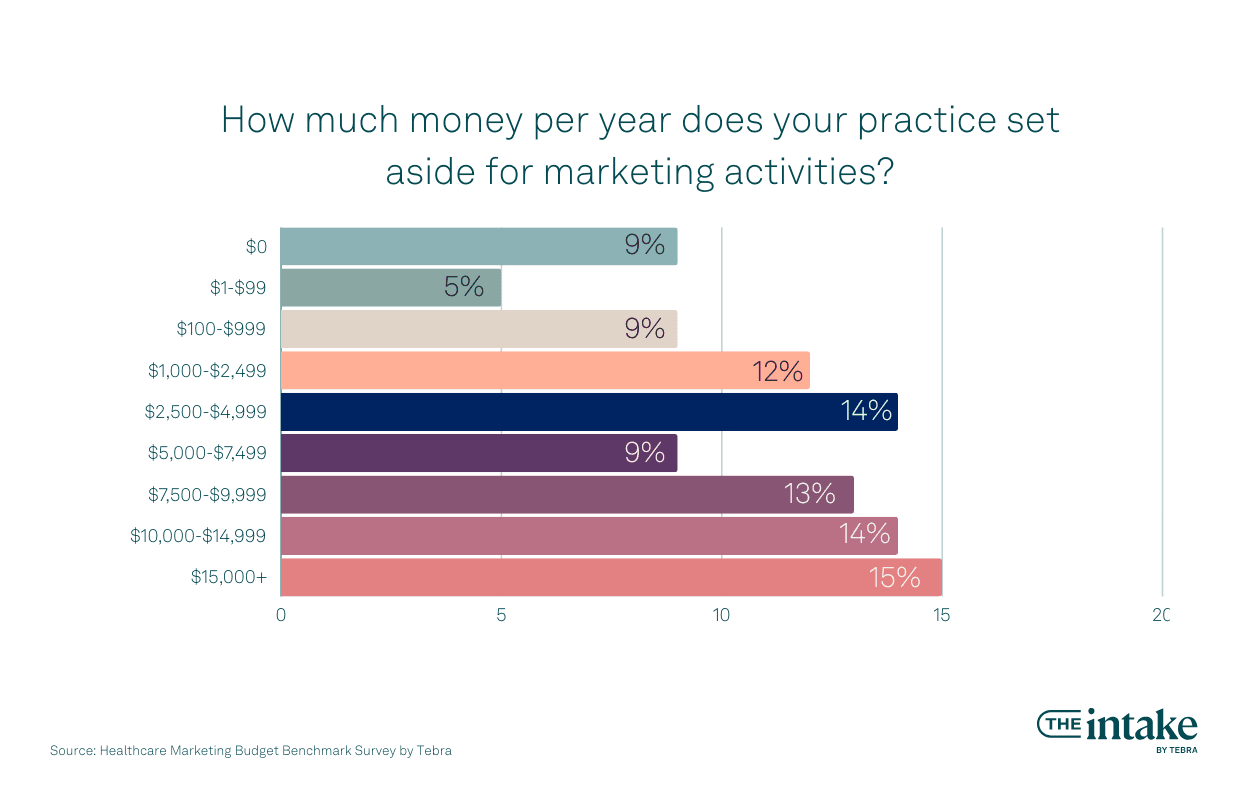
The majority of respondents (62%) spend 1%-5% of their practice′s gross revenue on marketing. The next bracket (14%) stated spending 6%-10% was their practice’s marketing spend, followed by similar figures for 11%-20% (6%), 21%-30% (5%), and 31%-40% (3%).
With most participants allocating a conservative 1%-5% of their practice's gross revenue to marketing, this highlights both an industry norm and an opportunity. The correlation we’ve already seen between higher marketing spend and potential revenue growth indicates that a more substantial allocation may boost practices’ revenue.
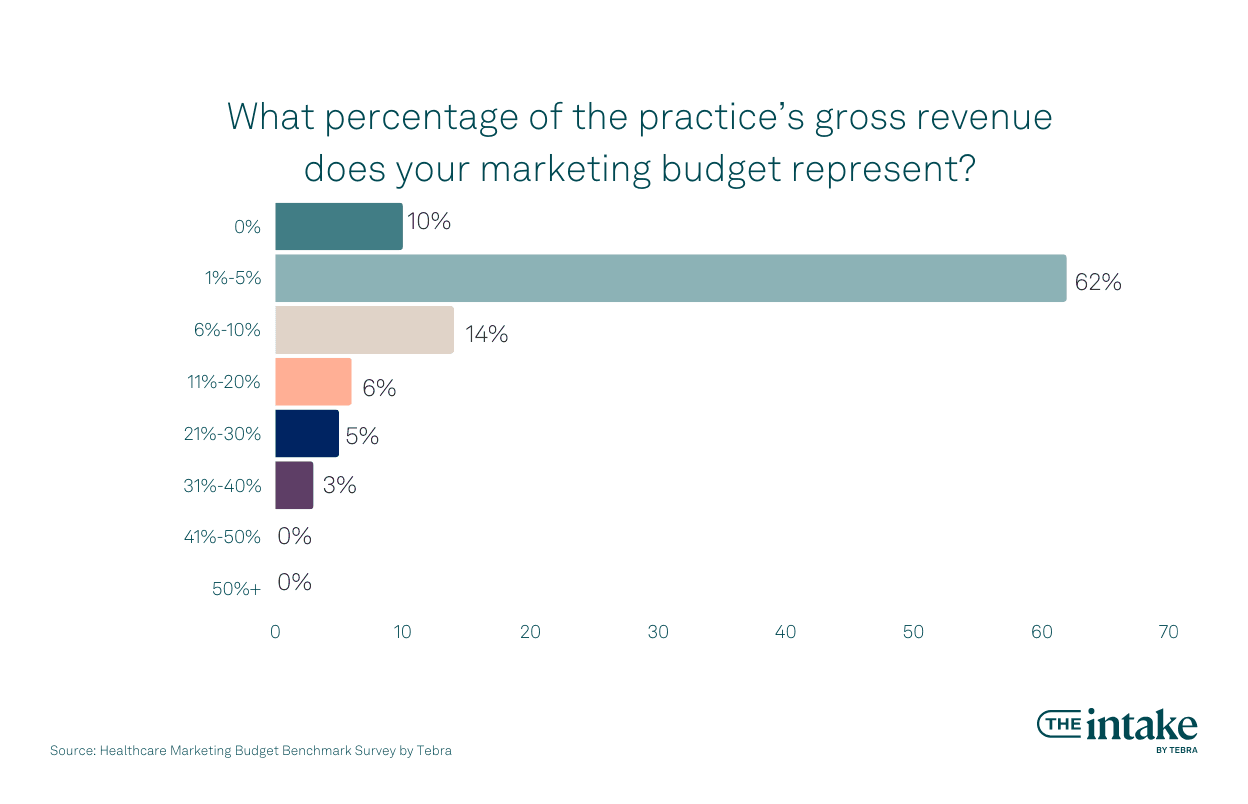
What about marketing agency fees?
While attracting visitors through a practice website and blog can be managed in-house, it takes considerable time and energy. Many practices choose to outsource to an agency with healthcare marketing experience to save time and improve their return on investment. A good agency brings expertise that can lower ad costs and achieve better outcomes.
When budgeting for a marketing partner, it’s helpful to understand common pricing models. For paid advertising campaigns, it's typical to spend around 25% of the ad budget on agency fees, according to a November 2023 Tebra survey of how private practice owners and managers allocate their marketing budgets. This usually covers copywriting, design, management, and reporting.
For a long-term investment like search engine optimization (SEO), costs are often structured differently. An initial project for a site review or new strategy can range from $5,000 to $15,000. Because search engines reward sites with fresh, current content, most practices also invest in ongoing SEO maintenance, which can cost anywhere from $2,500 to $10,000 a month.
Networking and referrals win over social media
When it comes to marketing expenses, private practices prioritize channels that have proven successful. Here are the top 3 areas of investment:
- Networking and referrals (50%): Getting referrals from other doctors and patients takes time and effort. Expenses often include attending health fairs and other events, and require materials like business cards, brochures, and promotional items.
- Online business listings (42%): Over 80 sites and platforms aggregate health provider info, so it's crucial to claim and update your listings.
- Online reviews and reputation management (37%): Managing your online reputation is crucial. One approach is manual, which can be time consuming. You can also use a tool like Tebra to update multiple listings at once. Automated tools can help you request reviews, while AI tools can help you respond quickly and identify trends.
Respondents spent the least on website hosting (19%) and digital marketing (19%), and only slightly more on email marketing (25%), direct mail campaigns (28%), and print ads (28%).
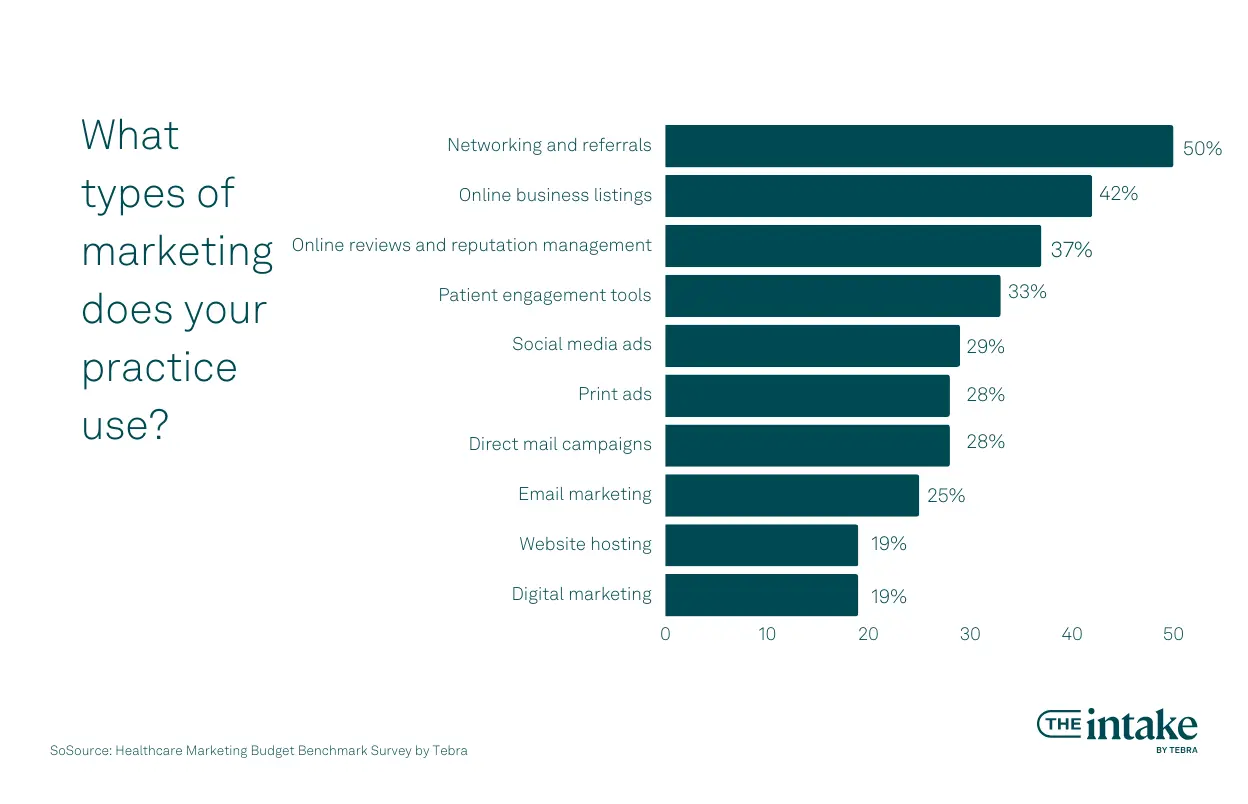
This leads us to the question, “What type of marketing has been most successful in your practice?” Respondents named:
- Networking and referrals (26%)
- Online reviews and reputation management (14%)
- Online business listings (11%)
This data indicates that the most frequently engaged marketing and networking activities among private practices were also reported as the most successful. Given the prevalence of these activities in their strategies, it aligns with their perceived effectiveness.
Tracking reviews and ratings
Online reviews and reputation management is a top marketing expense for practices, and also one of the most successful activities. A practice's online reputation is valuable currency and one of the most essential factors in healthcare marketing success. According to Tebra’s Patient Perspectives survey, 60% of patients said they Google (or use another search engine) to look for reviews of a healthcare practice, and 62% of patients said positive online reviews were an extremely or very important factor in their decision to choose a provider. In other words, reviews can be a prime decision-maker once a prospective patient finds you online.
A healthcare practice’s star rating is a critical indicator of how prospective patients will perceive its services. Therefore, it’s essential to track your star rating to keep it as high as possible — and promptly address patient feedback and any negative reviews.
This process is made much easier with review management software, which consolidates your online reputation management and gives you a better idea of how your star rating is changing over time. Automation is also an option, where an integrated system sends surveys automatically to patients after each visit, prompts patients to leave review feedback, directs negative feedback to the practice, and includes a dashboard for tracking and responding to most review sites
Download your free resource now
Access it instantly — just complete the form

Conversely, organic social media/influencer marketing, PPC, content marketing, and billboard/outdoor advertising were implemented less frequently. They also ranked lower in reported success. This suggests a potential discrepancy between engagement and effectiveness in these areas.
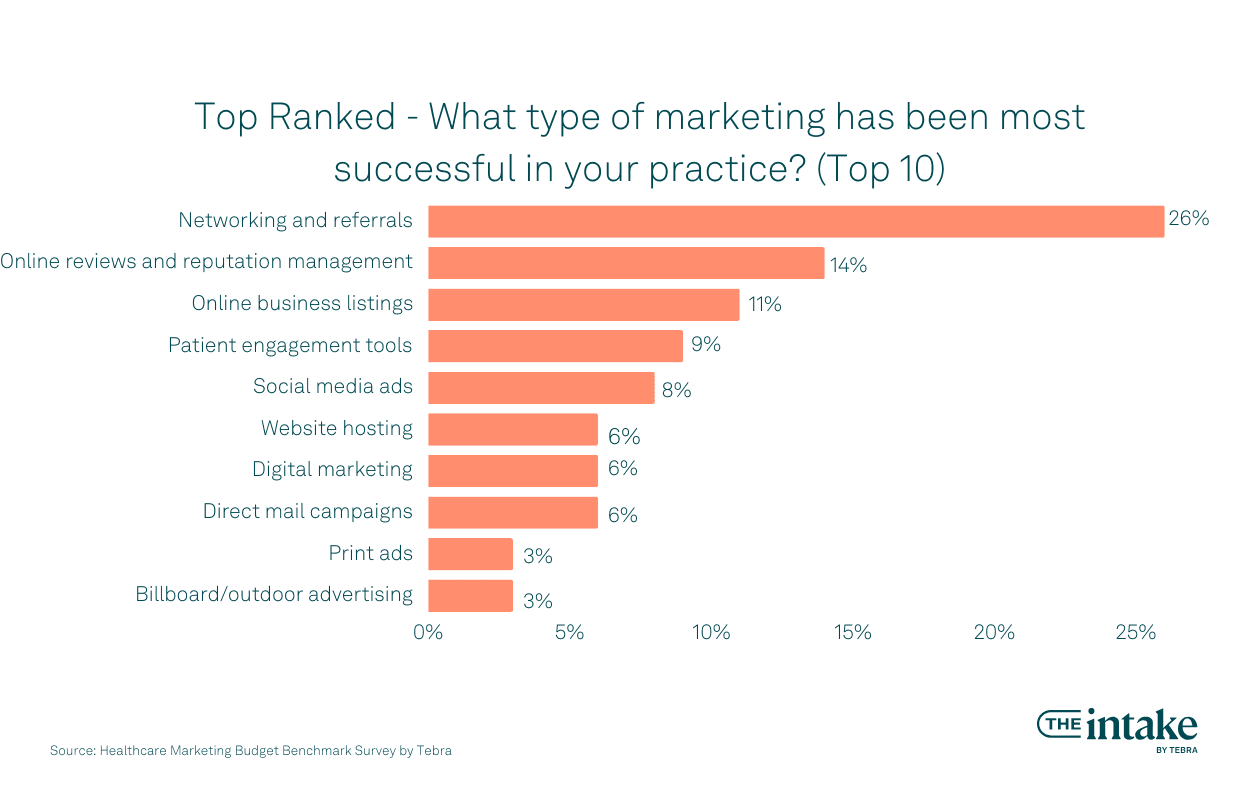
Assessing the effectiveness of marketing content
Are you deploying your content effectively? You won’t know unless you measure:
- Website bounce rates
- Time spent on each webpage
- Return visits
- Social media engagement
- Email conversion rates
- Brand mentions
Use these metrics to make data-driven decisions to improve your content strategy, like smartly repurposing and reposting popular content.
If you know you have a popular video or a high-traffic blog post, consider creating more content around that topic. When you break an existing topic down into smaller chunks, you can use it across your marketing channels (e.g., highlighting different pieces of information or using different visuals).
This practice boosts engagement and makes you appear to be creating more content than you actually are — just remember to keep things fresh by spacing out any reposts.
If you see that conversion rates are low on a piece of content, revisit it to make it more effective (e.g., changing the call-to-action). The more data you track, the better insights you’ll have about the success or failure of each piece of marketing.
One marketing staff member is the norm
Our survey reveals that it’s most common (44%) to have a single private practice staff member dedicated to marketing. Other practices (21%) dedicate 2 staff members, while still others (18%) have no in-house marketing support.
“Practices experiencing year-over-year revenue growth appear to invest more staffing resources into marketing.”
Regarding time investment, the distribution is diverse. While 11% allocate no time to marketing, a substantial 43% dedicate 1-5 hours per month, and 15% devote 6-10 hours. Only a small fraction (3%) invest 41 or more hours per month into marketing-related tasks.
Furthermore, the correlation between increased year-over-year revenue and the allocation of more staff time to marketing efforts highlights a significant connection. Practices experiencing year-over-year revenue growth appear to invest more staffing resources into marketing, potentially contributing to their revenue uptick.
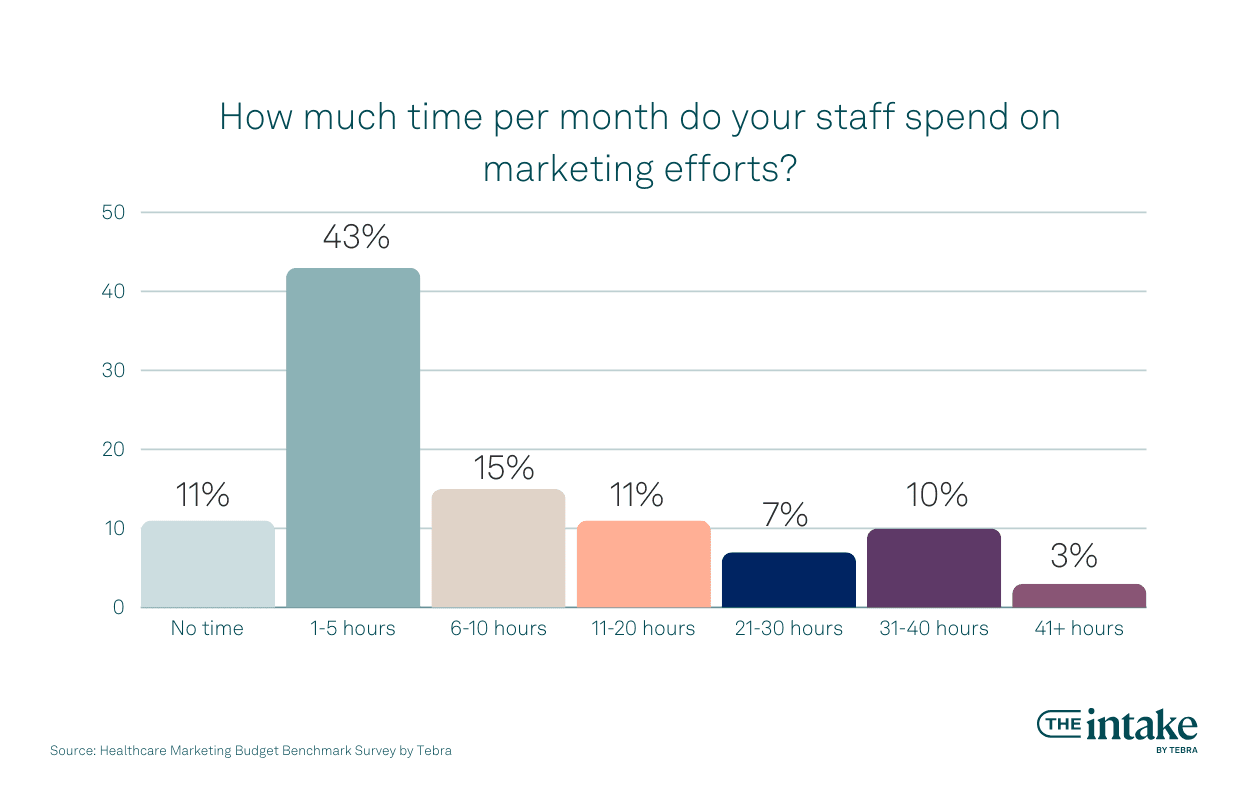
Attracting new patients is the priority for most
As well as analyzing the time spent and type of marketing activities, it’s important to recognize how independent practices calculate their marketing return on investment (ROI).
New patient acquisition (48%) was the top response, followed by online reviews and ratings (34%). The amount of net new revenue generated (32%) was the third most common answer.
The 5 least popular methods of measuring marketing ROI are as follows:
- Number of patient appointments (30%)
- Website traffic (25%)
- No ROI analysis (21%)
- Website search rankings (15%)
- Social media followers (15%)
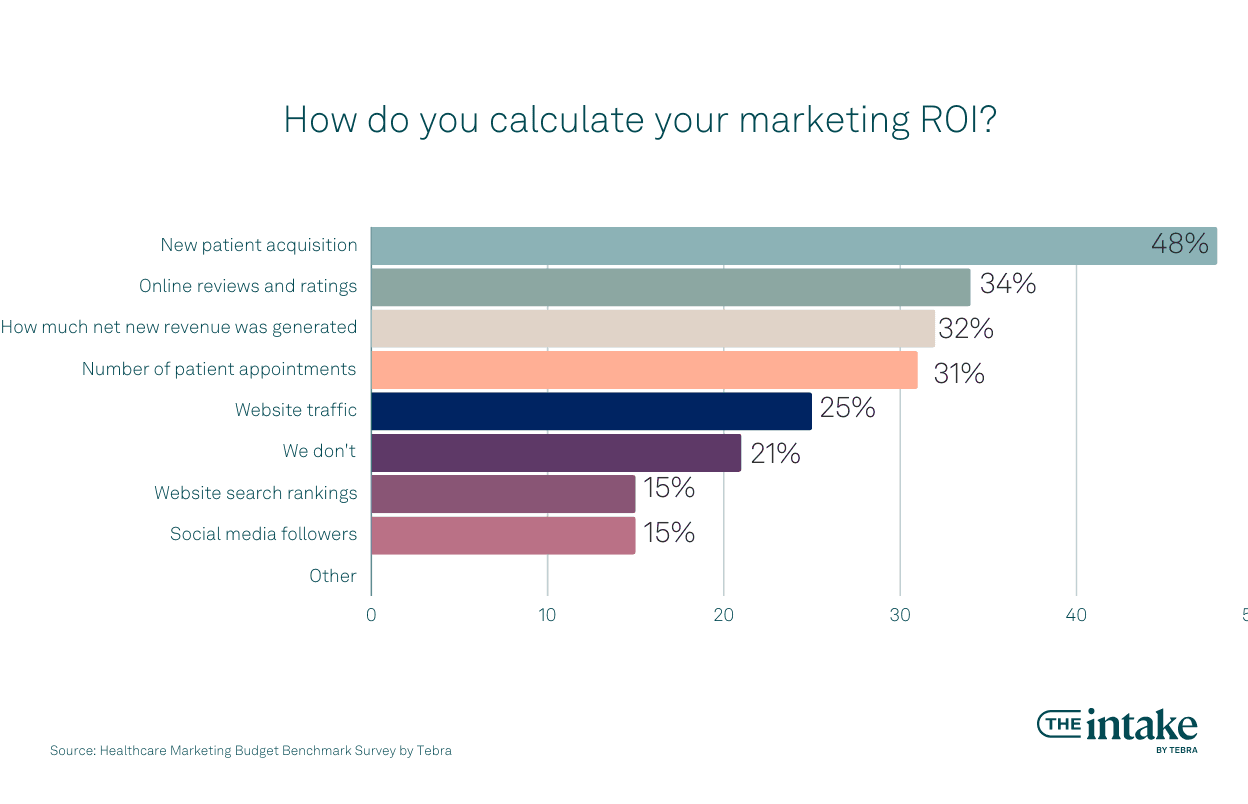
Understanding patient acquisition cost
Patient acquisition cost (PAC) is the amount of marketing and advertising dollars that a healthcare practice spends to acquire a new patient over a given period (e.g., a month, a year, or a quarter). To calculate your practice’s PAC, divide the total marketing and advertising spend by the number of new patients acquired during the chosen period.
Understanding PAC is critical in determining whether you’re getting good ROI and acquiring enough new patients to justify the investment you’ve put into the campaign.
In short, PAC helps practice owners decide whether they’re spending too much or too little on marketing and advertising.

How to measure ROI
In healthcare marketing, ROI looks at the profit generated from marketing campaigns relative to the costs. In the most successful healthcare organizations, Google Analytics, marketing automation platforms, and customer relationship management (CRM) systems are all used to measure ROI.
Make measuring your marketing campaigns’ ROI easier by using a vanity URL (a custom web address that is branded for marketing purposes) in a print ad, or by using unique links in pay-per-click ads to measure the traffic from that source.
Practices with online scheduling can track how many bookings result from a specific ad with a specific link. This tool allows you to measure the profit of those bookings. Dividing that information by the cost of the specific ad that prompted the bookings will determine the campaign’s ROI.
Once you know your ROI, you can determine where to make adjustments to your ads and website. Access to this data will help you make informed decisions about where to allocate your resources to attract and retain your target audience.

2024 marketing efforts
Notably, one practice stated, "We will not be doing any active marketing as our practice is currently too full to accept new patients." On the contrary, another reported new patient acquisition will be their priority in 2024. In fact, 18% of survey respondents will prioritize attracting new patients to their practices in the coming year.
The rest of the practices surveyed plan to improve their awareness in their communities of their business (6%), and 10% want to improve their word-of-mouth referrals.
Looking forward to the new year
Looking ahead to 2024, the projected shifts in marketing budgets among our surveyed practices indicate a trend of stability, with 65% anticipating no change in their budgets. Additionally, 31% plan to increase their marketing budgets, while a smaller subset (4%) anticipates a decrease.
This suggests a cautious yet optimistic outlook among these practices, with a substantial portion considering potential expansions in their marketing investments for the coming year.
The most important issues practices will focus on in 2024 will be managing workflow (27%), finding new patients (25%), and hiring talented people (19%).
The practices that experienced increased year-over-year revenue growth were twice as likely to say managing workflow is the first issue they will focus on compared to practices whose revenue stayed the same year-over-year.
These profitable practices were less focused on retaining existing patients (13%) and hiring talented people (15%), while practices with no revenue growth ranked patient retention at 22% and hiring at 31%.
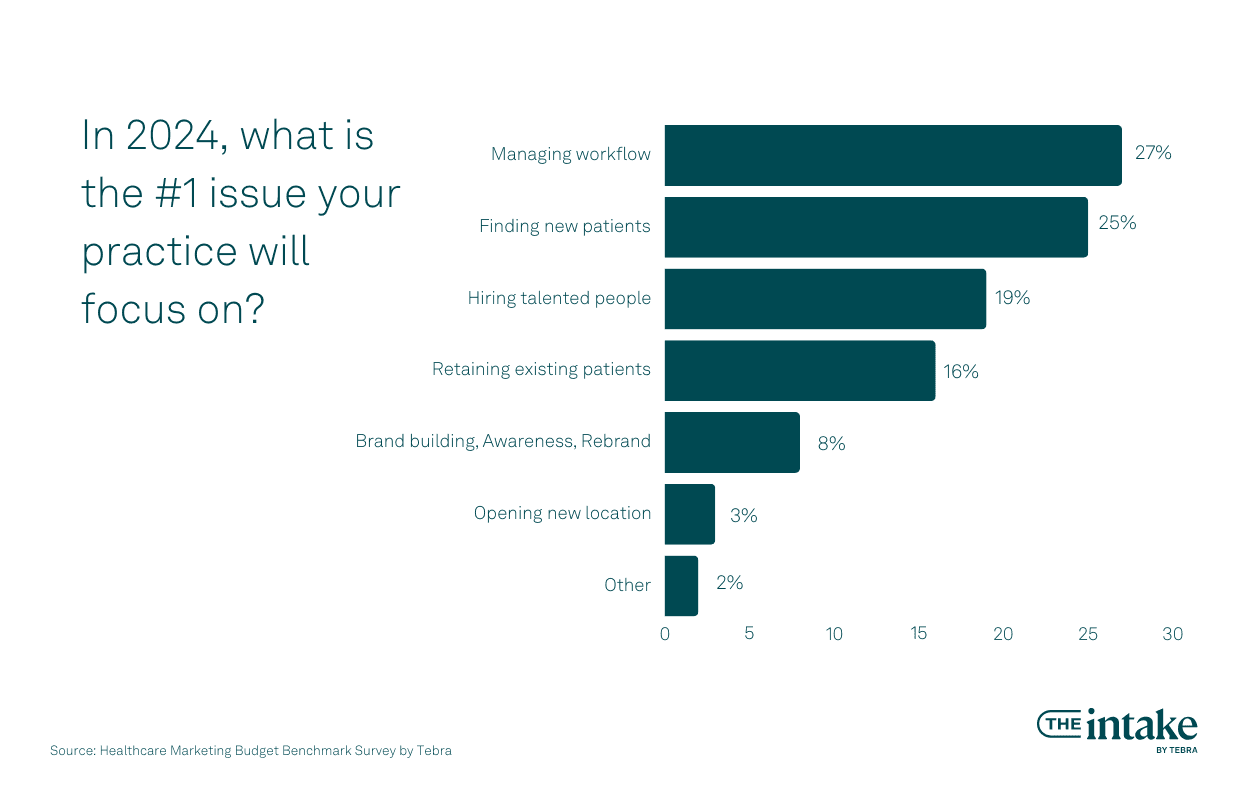
The most popular digital channels our respondents plan to invest in for 2024 are online reviews and reputation management (49%), online business listings (33%), and social media ads (29%).
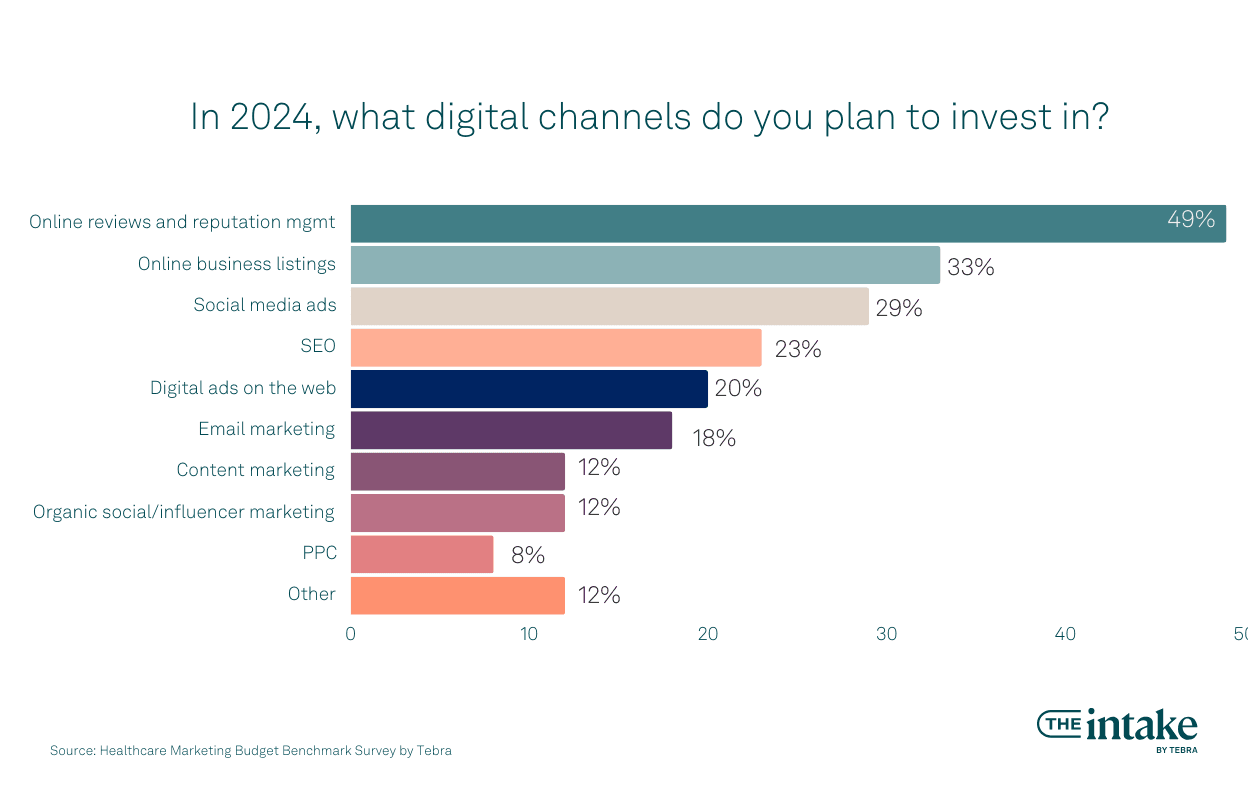
Biggest areas of planned marketing investments
Interestingly, the more successful practices state a higher likelihood of investing in PPC, digital ads on the web, and online business listings in 2024.
The biggest planned areas of marketing investments are:
- Online reviews and reputation management (28%)
- Online business listings (16%)
- Social media ads (11%)
- SEO (10%)
- Digital ads on the web (7%)
- Email marketing (6%)
- Organic social/influencer marketing (6%)
- Content marketing (3%)
- PPC (1%)
The top areas our surveyed practices seek marketing education and inspiration from are looking at competitor practices (39%), experimentation (34%), and following industry leaders and influencers (29%).
Respondent sound bites, when asked about their best marketing success story, included:
- "Patients refer other patients to us, entirely word of mouth, no cost to us."
- "Word of mouth referrals from patients for a boutique solo family practice with geriatric subspecialty. If you need to advertise, you are doing something wrong in your daily practice."
- "When we first moved to town, we sent out mailers, then word of mouth and great staff along with patient-centered focus built the practice."
Revenue is on the rise
The majority of practices we surveyed reported that their revenues have increased year-over-year (53%), while 35% stated they stayed the same. Only 12% experienced a decrease in their revenue on a yearly basis.
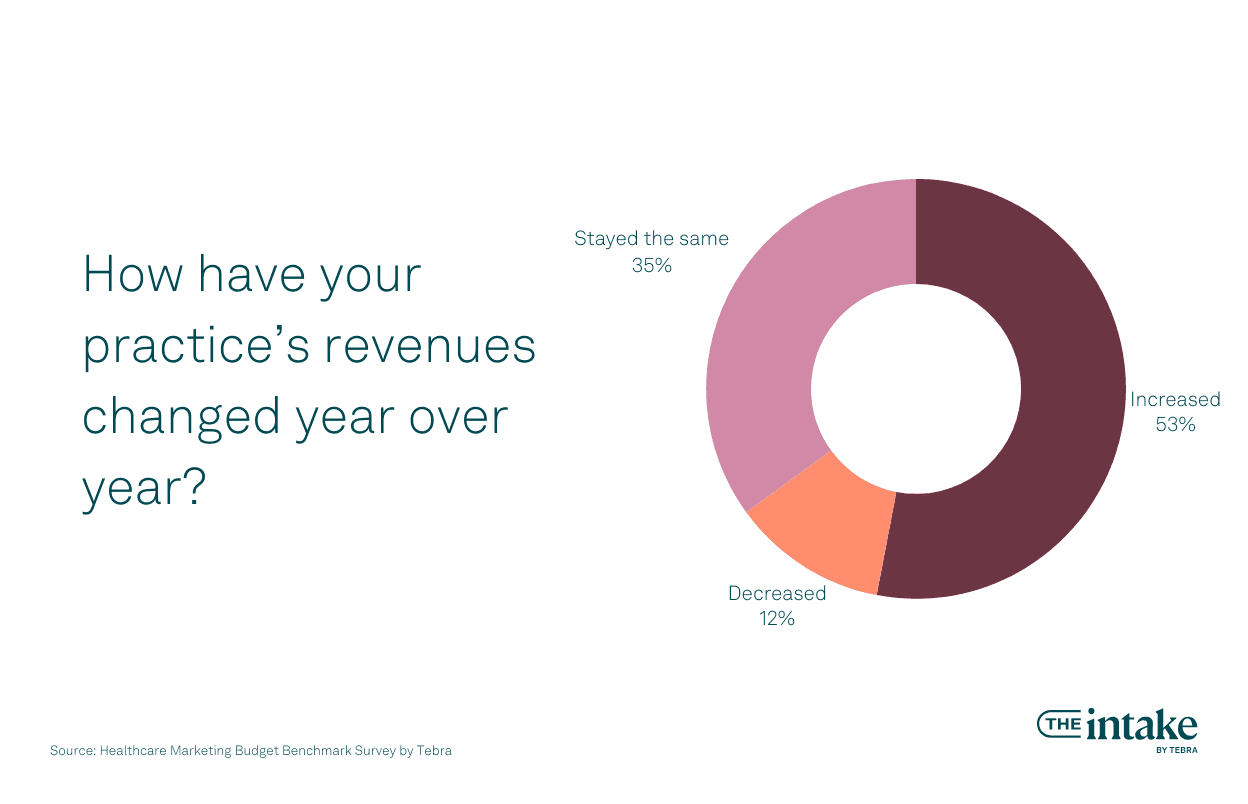
The typical growth among responses was between 6%-10% (45% of respondents). In addition, 24% experienced growth of 11%-20% in 2023 and 15% saw 1%-5% growth. Another 12% stated their practice’s business has grown by 21%-30%.
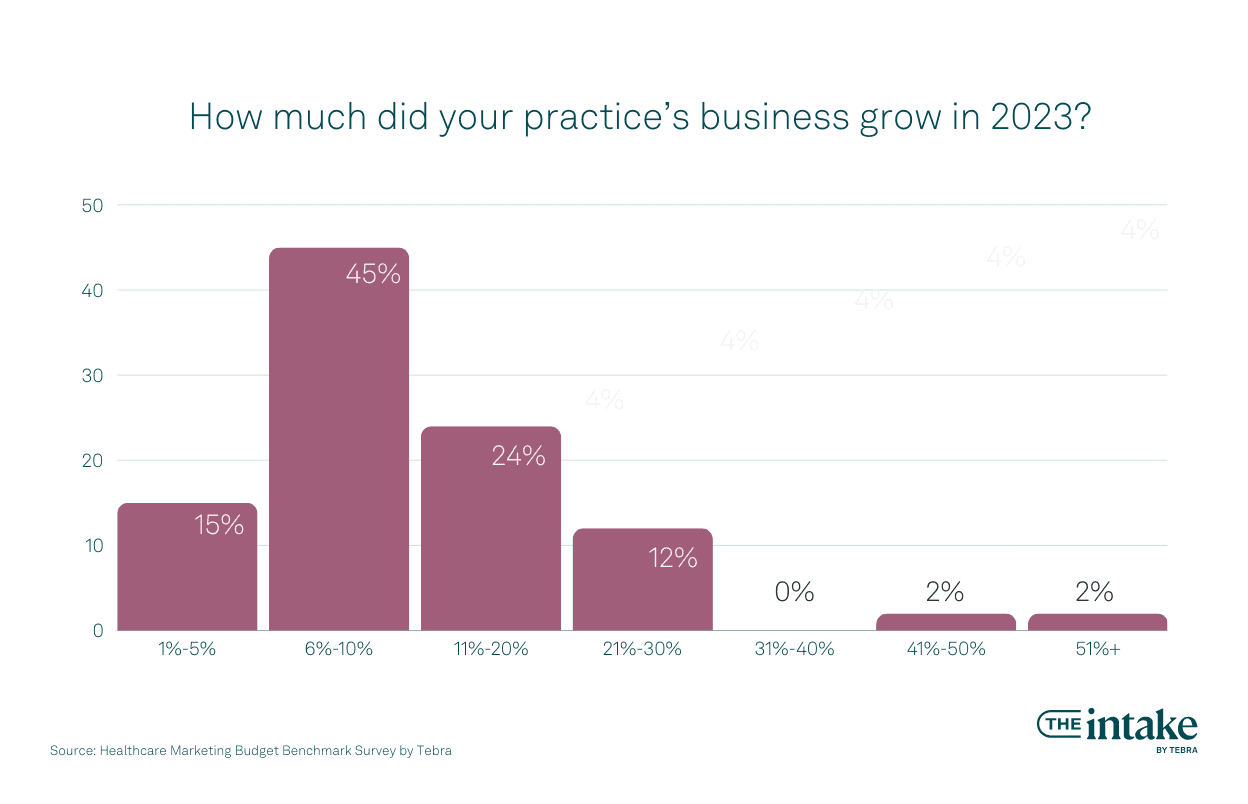
Practices are approaching marketing cautiously yet optimistically
Our report highlights a cautious approach to marketing among independent healthcare practices, as indicated by the stability in marketing budgets and the conservative allocation of funds.
However, the optimism comes through in the anticipation of potential expansions in marketing investments for the coming year, coupled with the majority of practices experiencing year-over-year revenue growth.
The combination of cautious decision-making and positive outcomes suggests a balanced and hopeful perspective for the industry as a whole.
Ways medical practices can invest in marketing
Like all marketing, healthcare marketing is open to creativity. There are always cost-effective marketing strategies you can implement at your practice. If you're ready to invest in marketing for your practice, consider the following 4 areas.
1. Define your target audience by making an ICP
Invest some time in defining your target patients: create a clear, concise Ideal Customer Profile (ICP). Creating an ICP means thoughtfully reflecting on your customer base and business services. When you do so, you’ll find that it highlights growth opportunities and patient needs, making it easier and faster to decide on the marketing content most suited to your practice.
2. Invest in a strong website
Having an SEO-optimized, high-conversion website is the baseline for establishing your practice as legitimate and professional. With just seconds to capture a visitor’s interest, your website and logo must be memorable, accessible, and user-friendly. Plus, a convincing website that’s easy to navigate — and provides a painless way to schedule an appointment — will see a higher conversion rate than one that isn't.
Patients tend to find the following pages most important:
- What services are offered
- Appointment availability, including any flexible appointment offerings
- Provider background information
- Patient testimonials
- Health and care advice
Consider using a live chat function for instant customer service, and be sure to correctly format your site so that the chat function is accessible on mobile devices.
3. Invest in a consistent online presence
Whether it’s through content marketing like SEO-optimized blog articles or through memorable and active social media channels, establishing your digital presence is a necessary investment for today’s independent medical practice. Your consistent online presence is invaluable for:
- Promoting brand visibility
- Generating leads
- Leading people back to your website
Medical SEO and building a social media presence are both ongoing projects that gain traction over time. The more consistently you contribute content in the digital space, the more likely it is that you’ll reach a growing audience.
In addition to organic reach, PPC ads are the most common way medical practices advertise online as they’re effective, targeted, and work for small businesses. Digital ads, especially PPC, are a great way to get quick wins, like acquiring new patients and boosting profitable services.
4. Invest in marketing data automation and analytics
Healthcare practices generate an enormous amount of data, a lot of it unstructured and coming in from different silos. Not only can it be a huge undertaking to “clean” and extract insights from this data, HIPAA compliance also needs to be considered.
Fortunately, today’s marketing automation systems make these challenges much more manageable for practice owners. Investing in automation lets you see your practice’s data in a more understandable format, making it clearer where to further invest and where to potentially cut back.
Better measurement for healthcare marketing: Putting focus back where it matters
With a thoughtful marketing strategy and a high-functioning data analysis system in place, the road to an increased patient base and high patient retention is significantly smoother. Independent practice physicians can take advantage of the additional time and resources and put their focus back where it matters most: improving their skills and prioritizing patient care and outcomes. Effective measuring of market campaigns isn’t just a goal to consider — it’s a key part of a thriving private practice.
Tebra’s patient experience suite will provide the solutions you need to improve your practice’s measured marketing approach.
Download your free resource now
Access it instantly — just complete the form

You might also be interested in
How patients find and pick their doctors. We surveyed more than 1,200 patients nationwide to understand factors that influence how they choose a doctor and why they keep coming back. Download the free report.
- Current Version – Sep 28, 2025Written by: Ryan YatesChanges: Updated with additional information and resources.
- Jul 08, 2024Written by: Ryan YatesChanges: Updated with additional information and resources.





